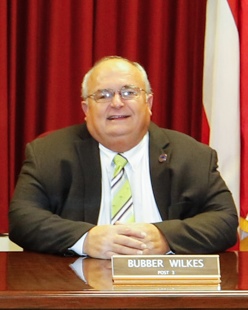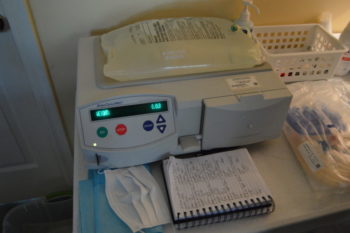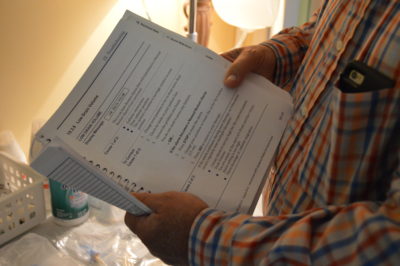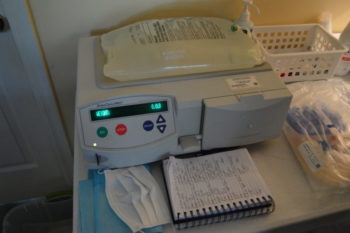W.E. “Bubber” Wilkes spent 30 years raising turkeys and then beef cattle, 24 years on the Oconee County Commission, and five years working security at Athens Regional Hospital.

And January will mark his first year on home dialysis for kidney failure.
Wilkes was born with only one kidney, but it was larger than normal and functioned well, he said. Many people can live normal lives with just one kidney, which is why so many people are able to donate one to somebody else. Because his single kidney stayed healthy for decades, Wilkes did not really worry about it or even give it much thought.
But after knee surgery last year, Wilkes, in his late 60s, developed cellulitis, a common but serious bacterial skin infection that can spread rapidly through the body. Although doctors couldn’t say for certain that the infection was what damaged his kidney, they told Wilkes it might have been the culprit. Anyhow, the damage had been done.
The kidney, which had done double duty for so long, started going downhill rapidly, dropping from functioning at around 20 percent to 10 percent in January 2016. His kidney specialist, Srilakshmi Rebala, told him he would need dialysis to survive.
The concept behind dialysis is simple, Rebala said. “The kidneys clear the toxins from the blood,” but when they are unable to do so, “dialysis does the job of the kidneys.”
The best-known type of dialysis requires patients to visit a specialized center for treatment.
But two forms of at-home dialysis are gaining popularity. Peritoneal dialysis uses the stomach membrane as a filter to remove fluids and wastes; home hemodialysis is essentially the same as the procedure used in clinics, but the equipment is more compact.
Not wanting to feel tied down
Wilkes knew that traditional hemodialysis requires patients to sit still while a machine circulates and filters their blood a little at a time. It removes waste and excess fluids from blood before pumping the blood back into the patient’s body.
[youtube]https://www.youtube.com/watch?v=moGAGyXLb1A[/youtube]“It’s kind of heartbreaking to see them sitting in there like that and hooked to those machines for four and five hours at a time,” Wilkes said. “Your whole day is gone. That’s Monday, Wednesday and Friday — three days a week.”
Wilkes wasn’t interested in spending his days attached to a machine. One of his nurses told him that peritoneal dialysis, which he could do at home, was an option.
He hoped this would be a better fit for his lifestyle — he still works part time at a funeral home and as a county commissioner despite considering himself “retired.” But he and his wife, Gwen, knew that learning to work something as complex as a dialysis machine might be tough.
The nephrology center staff told Wilkes about a specific machine that not only automated peritoneal dialysis but also was covered by Medicare and most private insurers. And they informed him that learning to use it properly would require hours of training.
“When I brought it home, I was still unsure,” he recalled recently. “I said, ‘I don’t know, Gwen.’ But once we got it here, I was determined.”

His wife said that learning how to work the machine was “kind of trial and error at first.”
“To begin with, he just wasn’t getting it,” Gwen Wilkes said. “He’s kind of a hard learner when it comes to all that. It was a matter of almost forcing him to do it on his own.”
But now Bubber Wilkes is the boss of the machine. “I think he found out that it was easier to maintain it than he thought,” his wife said.
Not suited to everyone
In-home dialysis is not new, but Medicare recently started promoting it, partly because it’s less expensive than going to a dialysis center and partly because it improves the patient’s quality of life.
At-home peritoneal dialysis is catching on but still accounts for only a little over 5 percent of the roughly 366,000 patients on dialysis in the nation, according to the National Institute of Diabetes and Digestive and Kidney Diseases. Rebala said her goal is to get at least half of her patients on home dialysis because of its quality-of-life benefits. She already works with more at-home dialysis patients than fellow nephrologists in the Athens area.
“I tell the patients, ‘You are in total control when you do the home dialysis,’ ” Rebala said. “Let us say they had more fluid intake because they had a party or a get-together the day before. They can actually adjust the fluid removal on the dialysis machine. If they need to do an extra dialysis session, they can do that. In-center, there is only so much you can remove.”
Home dialysis provides a level of independence that appeals to people who are still active and working. At night, Wilkes can move around fairly freely while he’s hooked up to the machine. The tube connecting him is long enough that he can work at his computer desk or sit in his large leather recliner. In the morning, he unhooks the device and can go about his day like anyone else.

Not all patients are good candidates for automated peritoneal dialysis. Support from family and friends is vital for people learning to operate the machine, and some people are simply intimidated by the thought of doing it themselves, Rebala said. Infection is a frightening and very real risk if everything is not done just right.
Wilkes is on the kidney transplant list but won’t be able to receive a donated organ until he can lose weight. Meanwhile, the support of his wife, family members and community has been instrumental in helping him keep a positive outlook.
“Got a lot of good folks behind me praying for me,” he said.
Leigh Beeson is a graduate student at UGA in the health and medical journalism program. She had a bachelor’s degree in communications and was editor-in-chief of her undergraduate university’s newspaper.

